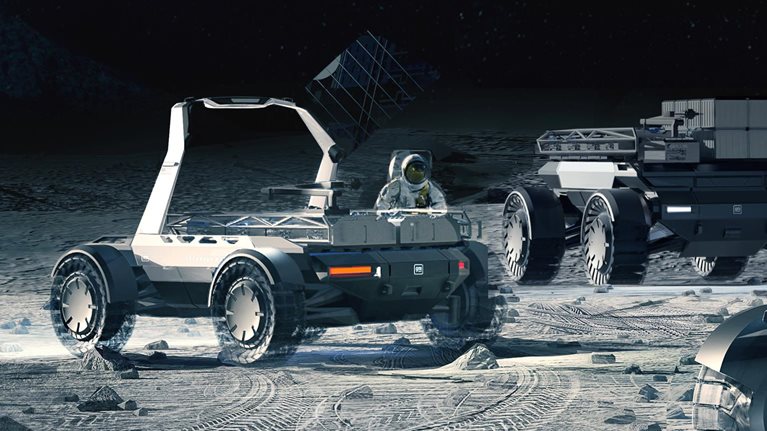Space is becoming more crowded, both literally and figuratively. There are thousands more satellites in outer space than in years past (with thousands more on the way), and more companies competing in the space industry than ever before. That’s exciting to Debra Facktor, who has spent her entire career in the aerospace sector and who, in March 2020, assumed the role of head of U.S. Space Systems for Airbus U.S. Space & Defense.
Facktor recently spoke with McKinsey’s Jess Harrington about her responsibilities at Airbus U.S., the future of the aerospace sector, and her experience as a woman in a male-dominated industry. Excerpts of their conversation follow.
McKinsey: First, tell me about your job. What areas are you focused on?
Debra Facktor: I’m an engineer by training, but I don’t do engineering every day anymore. My job today is running our U.S. Space Systems line of business, which encompasses small satellites, human space flight, and space exploration. I manage a team of great people who understand all the technical aspects of building satellites and traveling out to space.
The biggest part of my job is business development for our small satellites: showcasing our satellites’ capabilities to customers. I sit on the board of Airbus OneWeb Satellites, which is our joint venture with [London-based communications company] OneWeb, so part of my job is providing leadership on the manufacturing side—making sure that our satellites are built on time, on budget, at high quality. These days I spend a lot of my time on email, it seems, and on virtual phone calls. I’m starting to do a little bit more travel, like to our factory in Florida where we make satellites.
Another part of my job is overseeing our US human space flight and space exploration business. For example, Airbus invested in the Bartolomeo platform, which is a large, payload-hosting platform attached to the International Space Station. So, if a company or agency wants to send a payload out to space—say, for Earth observation or for a scientific experiment—it can use our service.
The space economy of the future
McKinsey: It’s amazing how many companies are now venturing out into space. I’d love your thoughts on where the space sector is headed in the coming years. What new kinds of economic activity might we see in space by 2030?
Debra Facktor: Well, for one thing, I think there will be major advances in human space flight. Even in the past year, we’ve seen great progress in the accessibility of space. In planning your 2030 vacation, you might be able to choose between taking a quick trip to Florida or taking a quick trip to space.
In 2030, when thousands more satellites will be orbiting the Earth, a new opportunity in space might be the on-orbit servicing of satellites. We’re starting to see some companies invest in [on-orbit] refueling or repair services, whether it’s to provide a propulsive boost to the correct orbit or to fix a dead battery.
Today, if your car breaks down on the side of the road at midnight, you can call a service like AAA [American Automobile Association]. You have their phone number; you trust them to come and jump your battery or repair your tire. Imagine you break down on that same road at midnight and a stranger comes up and says, “I’ll fix your car.” You’d probably say, “No, thank you. I’m going to wait until AAA comes or until the police come.” The same thing can happen in space: What is the trusted service for satellites? These are some of the issues for companies to work out. It’s about building not just the technical pieces but also the trustworthiness that makes that kind of business model work.
McKinsey: The notion of trustworthiness in space is interesting; it also comes into play when you think about the increasing risk of collisions in space. What do you see as the greatest threats to the continued growth in space activity between now and 2030?
Debra Facktor: One is overcrowding in space. As you said, with all the thousands of satellites and the human space flight missions going on, there’s more debris and a greater likelihood of things hitting each other. We need to be mindful of our behaviors in space when it comes to space debris. We need to be good neighbors. One of the principles of the US Forest Service, for example, is “pack it in, pack it out”: if you go camping in the woods and create trash, you pack up that trash and bring it back out with you. We need to create those kinds of norms in space.
Another concern is protection of information and cybersecurity. We’re all worried about identity theft or spam in our emails, but what happens if our weather satellites start putting out spam? How does that affect airplanes during landing? That’s just one example. We need to protect both the physical assets and the way that data comes to us, because we rely on that data on a day-to-day basis. One promising technology is laser communication, which will enable more secure communications from one satellite to another, and also between satellites and the ground. When data is communicated via laser, it’s less easily intercepted or jammed than when you’re transmitting using radio frequencies.
Government and industry
McKinsey: Who do you think will be providing space technologies? In other words, what will the space ecosystem look like in 2030? Will it be a mix of billionaire-backed start-ups and larger, traditional players like Airbus?
Debra Facktor: I think the space ecosystem in 2030 will still be a mix of government and industry players but maybe playing different roles. I believe there’s always a role for the government—first of all, to invest in R&D that perhaps has no direct commercial application but enables the next generation of STEM [science, technology, engineering, and mathematics] research and engenders creativity and learning. That will continue to be important. Government will take risks where industry is not able to and will continue to provide a reliable infrastructure, a common regulatory regime, and a predictable contractual and legal business environment. All of that is important for commercial companies to succeed.
Commercial companies, on the other hand, innovate by coming up with new applications for existing technologies—including applications that we don’t even know we need. The microwave oven didn’t come about because somebody said, “I need to microwave my food.” You didn’t even know you needed one until it existed; the same thing happened with the cell phone.
What we’re starting to see today, and what could happen frequently by 2030, is that those roles reverse: commercial companies will start challenging the assumptions that the government makes and investing a lot more in rapid-cycle R&D. The government might then take those commercial investments to a new level. We’re already seeing a few examples of that, with the government taking advantage of commercial launch vehicles and commercial investments in low-Earth-orbit satellites, like those we are building in our factory in Merritt Island, Florida.

The future of space: It’s getting crowded out there
Tomorrow’s space workforce
McKinsey: Obviously, given the heightened interest and activity in space, the industry will need to attract more talent. What does the ideal 2030 space workforce look like, and what needs to happen to make it look that way?
Debra Facktor: I love the fact that young people are still excited about space and want to come into our industry. Many little kids want to become astronauts. I hope that, in schools, we continue to encourage young people to be successful in math, science, and technical fields but also recognize that other fields are needed in the space industry. People who know how to communicate, people who know how to draw up contracts, experts in political science, experts in the arts—these are all important parts of our space ecosystem.
One of the most important things we can do is to continue to invest in talent and encourage young people—especially women and underrepresented minorities—to go into fields like aerospace. There are a number of new fellowships designed to help make the aerospace industry a more diverse and dynamic environment, and the individuals who become alumni of these fellowships are going to change the world. I really want to see space companies and agencies have equal representation of women and minorities.
McKinsey: There’s already so much competition in the space sector, and it’s only going to intensify. What do you think will differentiate companies by 2030? Will it be technology? Will it be an operating model? Or some combination of those factors?
Debra Facktor: The number one way for a company to differentiate itself is through its culture and how it treats people. The environment you create inside your company is a reflection of the service and product that you deliver to your customers and shareholders. A company can have great technologies but then execute poorly because the culture isn’t there. Conversely, a semi-good idea that people think is just so-so—if you put it with the right team that has the passion and ability to innovate—can turn out beyond all expectations.
So I don’t think the differentiator will be a particular technology or business model. It’s all about the people and the experience. If you have a good experience, regardless of what the product or service is, and the people are enjoying what they do while delivering it, that’s what makes for a good company. Companies with a strong, positive, and inclusive culture are the ones that will survive.


